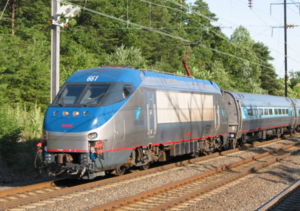HHP-8
 HHP-8 661 at BWI Rail Station | |
| Power type | Electric |
|---|---|
| Builder | Bombardier Transportation |
| Total production | 21 |
| AAR wheel arr. | B-B |
| Gauge | 1,435 mm (4 ft 8½ in) |
| Electric system | 11,000 V AC, 25 Hz 11,000-13,500 V AC, 60 Hz 25,000 V AC, 60 Hz |
| Collection method | Overhead AC with dual pantographs |
| Top speed | 125 mph (201 km/h) for Metroliner and Regional 90 mph (145 km/h) for long-distance trains |
| Power output | 8,000 hp |
| Career | Amtrak and MARC |
| Number | AMT 650-664; MARC 4910-4915 |
| Nicknames | Bananas; Rhinos |
| Locale | Amtrak's Northeast Corridor between Boston and Washington, DC |
The HHP-8 is a double-ended electric locomotive manufactured by the consortium of Bombardier and Alstom. The HHP-8 stands for High HorsePower with 8000 hp. The HHP-8s essentially replace the GE E60s and supplement the aging AEM-7 engines in service for Amtrak's Northeast Corridor, though some of the AEM-7s have been upgraded to AEM-7ACs to match the hauling power of the HHP-8. The engine can haul lengthy runs of Amfleet cars at speeds up to 125 mph. It is sometimes referred to by train crews as the "Rhino." Maryland Rail Commuter (MARC) also operates HHP-8s on its Penn Line between Perryville and Washington, DC.
The engines are very similar to the Acela Express power cars except that the noses of the HHP-8s are noticeably shorter and stubbier. The front end is also equipped with couplers and HEP receptacles. On the other hand, the couplers of the Acela Express power cars HEP receptacles hide behind a cover during normal operations.
During testing of the equipment between 1999 and 2000 the engines have experienced a number of problems related to the differing electric voltages found on the Northeast Corridor. They were designed to automatically switch to accept the different voltages, but this feature has malfunctioned in practice. Moreover, cracking in the trucks was identified as a potential problem during testing. Safety officials at the time felt that potential crack development could be identified before failure with proper inspection.
In August 2002, similar to the woes of the Acela Express trainsets, the HHP-8s were also briefly removed from service when the brackets that connected truck dampers (shocks) to the locomotive carbodies ("yaw dampers") were found to be cracking. The locomotives were then returned to service when a program of frequent inspections was instituted. The damper brackets have since been redesigned and the old brackets replaced with the newer design.
